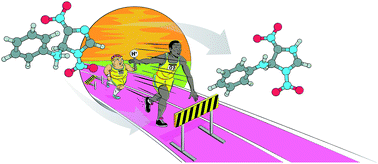Origins of the ANRORC reactivity in nitroimidazole derivatives†
Abstract
The mechanism of the ANRORC-like ring transformation of nitroimidazole derivatives towards aniline has been studied by fully exploring the potential energy surface (PES). For this purpose the reaction of some aniline derivatives towards 1,4-dinitro-1H-imidazole, 2-methyl-1,4-dinitro-1H-imidazole and 5-methyl-1,4-dinitro-1H-imidazole and have been employed as model reactions. The study reveals that the most favorable path involves an initial amine attack at the C(5)–C(4) bond of the imidazole moiety, where the imidazole distortion appears to be the main factor for the favored nucleophilic attack on the C(5) site. We further show that the reaction regioselectivity is independent of the substitution patterns on the aryl moiety. Next, we highlight the key role of the proton transfer along the reaction pathway of the title reactions to allow a successful connection between two energetically lower regions along the PES: an electrophilically activated ring-opening step followed by the favored 5-exo-trig cyclization. Additionally, we show that this 5-exo-trig cyclization step is the rate determining step. Finally the tether strain and steric effects present in the rate determining TS structure are evaluated by means of the distortion/interaction model.


 Please wait while we load your content...
Please wait while we load your content...